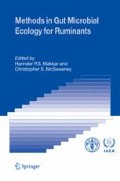Access this chapter
Tax calculation will be finalised at checkout
Purchases are for personal use only
Preview
Unable to display preview. Download preview PDF.
References
Bryant, M.P., and L.A. Burkey. 1953. Cultural methods and some characteristics of some of the more numerous groups of bacteria in the bovine rumen. J. Dairy Sci. 36:205–217.
Dehority, B.A. 1969. Pectin-fermenting bacteria isolated from the bovine rumen. J. Bacteriol. 99:189–196.
Dehority, B.A. 1984. Evaluation of subsampling and fixation procedures used for counting rumen protozoa. Appl. Environ. Microbiol. 48:182–185.
Dehority, B.A. 1986. Protozoa of the digestive tract of herbivorous mammals. Insect Sci. Appl. 7:279–296.
Dehority, B.A. 1993. Laboratory Manual for Classification and Morphology of Rumen Ciliate Protozoa. CRC Press, Inc., Boca Raton, FL.
Dehority, B.A. 1995. Rumen ciliates of the pronghorn antelope (Antilocapra americana), mule deer (Odocoileus hemionus), white-tailed deer (Odocoileus virginianus) and elk (Cervus canadensis) in the northwestern United States. Arch. Protistenkd. 146:29–36.
Dehority, B.A. 1998. Generation times of Epidinium caudatum and Entodinium caudatum, determined in vitro by transferring at various time intervals. J. Anim. Sci. 76:1189–1196.
Dehority, B.A. 2003. Rumen Microbiology. Nottingham University Press, Nottingham, UK.
Göçmen, B., B. Falakali Mutaf, and M. Tosuno lu. 2001. New rumen ciliates from Turkish domestic cattle (Bos taurus L.): IV. Eudiplodinium dehorityi n. sp. Acta Parasitol. Turc. 25:305–307.
Gruby D., and O. Delafond. 1843. Recherches sur des animacules se développant dans l’estomac et dans les intestins pendant la digestion des animaux herbivores et carnivores. C. R. Acad. Sci. 17:1304–1308.
Guirong, Su N., Z.X. Hua, S. Zhu, and S. Imai. 2000. Rumen ciliated protozoan fauna of the yak (Bos grunniens) in China with the description of Entodinium monuo n. sp. J. Eukaryot. Microbiol. 47:178–182.
Hungate, R.E. 1950. The anaerobic mesophilic cellulolytic rumen bacteria. Bacteriol. Rev. 14:1–49.
Hungate R.E. 1966. The Rumen and its Microbes. Academic Press, Inc., New York.
Ito, A., N. Arai, Y. Tsutsumi, and S. Imai. 1997. Ciliate protozoa in the rumen of sassaby antelope, Damaliscus lunatus lunatus, including the description of a new species and form. J. Eukaryot. Microbiol. 44:586–591.
Kofoid, C.A., and R.F. MacLennan. 1930. Ciliates from Bos indicus Linn. I. The genus Entodinium Stein. Univ. Calif. Publ. Zool. 33:471–544.
Kofoid, C.A., and R.F. MacLennan. 1932. Ciliates from Bos indicus Linn. II. Arevision of Diplodinium Schuberg. Univ. Calif. Publ. Zool. 37:53–152.
Kofoid, C.A., and R.F. MacLennan. 1933. Ciliates from Bos indicus Linn. III. Epidinium Crawley, Epiplastron gen. nov., and Ophryoscolex Stein. Univ. Calif. Publ. Zool. 39:1–34.
Nsabimana E., S. Kišidayová, D. Macheboeuf, C.J. Newbold, and J.P. Jouany. 2003. Two-step freezing procedure for cryopreservation of rumen ciliates, an effective tool for creation of a frozen rumen protozoa bank. Appl. Environ. Microbiol. 69:3826–3832.
Ogimoto, K., and S. Imai. 1981. Atlas of Rumen Microbiology. Japan Scientific Societies Press, Tokyo.
Orpin, C.G. 1977. The occurrence of chitin in the cell walls of the rumen organisms Neocallimastiz frontalis, Piromonas communis and Sphaeromonas communis. J. Gen. Microbiol. 99:107–117.
Purser, D.B., and R.J. Moir. 1959. Ruminal flora studies in the sheep. IX. The effect of pH on the ciliate population of the rumen in vivo. Aust. J. Agric. Res. 10:555–564.
Williams, A.G., and G.S. Coleman. 1992. The Rumen Protozoa. Springer-Verlag, New York.
Author information
Authors and Affiliations
Editor information
Editors and Affiliations
Rights and permissions
Copyright information
© 2005 IAEA
About this chapter
Cite this chapter
Dehority, B.A. (2005). Ciliate protozoa. In: Makkar, H.P., McSweeney, C.S. (eds) Methods in Gut Microbial Ecology for Ruminants. Springer, Dordrecht. https://doi.org/10.1007/1-4020-3791-0_6
Download citation
DOI: https://doi.org/10.1007/1-4020-3791-0_6
Publisher Name: Springer, Dordrecht
Print ISBN: 978-1-4020-3790-0
Online ISBN: 978-1-4020-3791-7
eBook Packages: Biomedical and Life SciencesBiomedical and Life Sciences (R0)

